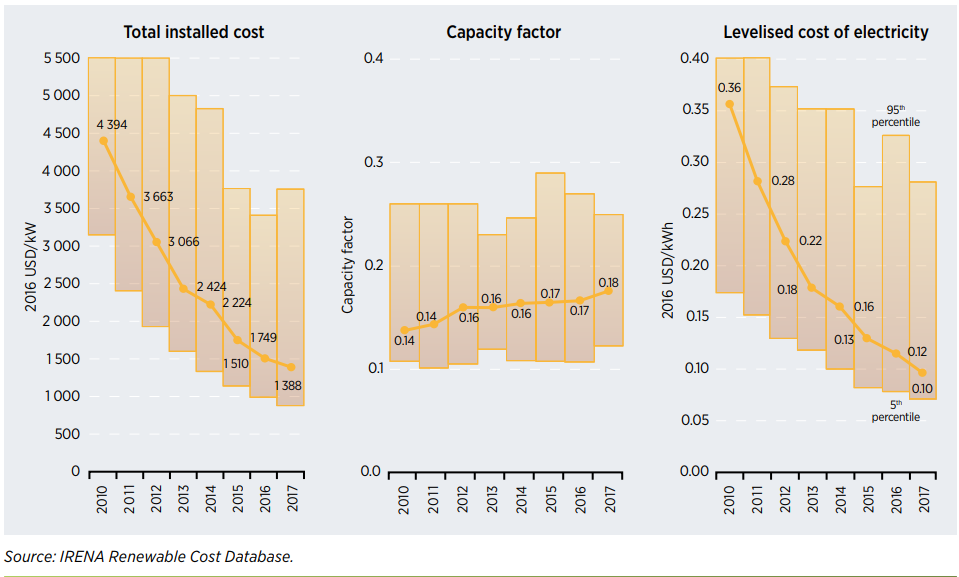Australian commercial solar, lowest cost in the world.
Solar generation, more accessible than ever before.
In 2018, Australia experienced unbelievable uptake on solar. A record of 450 large scale solar projects totaling 2 GW of capacity were registered in the Large-Scale Generation (LGCs) market, which is larger than many nuclear power stations. A total of ~1.6 GW’s of residential and commercial solar systems with a capacity of 0-100kW were also installed in 2018.
This is nearly 50% higher than 2017, and ~60% higher than 2012 when government rebates and feed-in tariffs were at their peak. There have now been over 2 million solar systems installed in Australia, and solar contributed about 4% to total electricity generation in the NEM in 2017/18.
Increasing demand and enquiries from the strata industry
We have been receiving an increasing number of enquiries and interest regarding the application of solar into strata communities. Solar is an excellent way to reduce energy costs within strata buildings. Both within embedded networks where the benefits can be shared across all residents, and to directly reduce common power costs to body corporates.
This article is intended to provide an update of the current trends in the solar industry both in Australia (above) and globally (below), and show evidence of the remarkable fact that solar is now considered in most applications, the lowest cost form of energy. In addition, we identify key considerations for strata communities when considering installing solar.
PV cost trends
The International Renewable Energy Agency (IRENA) said it best with the caption “Renewables are experiencing a virtuous cycle of technology improvement and cost reduction”. Solar photovoltaics are experiencing a continuous reduction in costs and improvements in technology.
According to IRENA, Australia has the lowest levelised cost of energy from commercial solar systems in the world, at only 10 US cents per kWh. (Note: A commercial solar system is defined as <500kW. The levelised cost of energy can be simply defined as lifetime costs divided by energy generation, and is an accepted method of comparing different energy technologies)
The graph below is quite informative, the left chart demonstrates the continued rapid fall in the cost to install a solar system, the middle graph shows the improvements in technology and performance, and the right graph shows how far the cost of producing solar has fallen. All of the charts demonstrate the remarkable achievement of making all these significant improvements in a very short period of time.
The following chart allows demonstrates a key point – solar energy is now lower cost than most fossil fuels, and may be lower cost than all fossil fuels within the next decade.
Site conditions in strata application
Humenergy works with Australian businesses and Strata Communities to deliver smart, tailored solar power systems that will immediately lower energy usage. Our clean solar solutions will help drive significant savings through reduced reliance on the grid with the use of your own clean, reliable energy source.
When considering the installation of solar into a strata building, there are a number of additional important factors that require consideration:
Building height –
This is an important factor regarding the feasibility and practicality of the project. Basically, high buildings have small roof areas compared to energy consumption. Installation of solar on such buildings is unlikely to be feasible or sensible due to high costs, higher safety risks, and relatively small energy reductions.
Roof construction and materials –
Concrete roofs require extra attention to ensure that ongoing maintenance issues are not created by leaks or corroding materials.
Roof access for maintenance –
The roofs of strata buildings often require maintenance access for resealing membranes, or attaching safety lines for window cleanings, or equipment maintenance or replacement. This should be considered during the design and sizing stage of the solar projects.
Embedded networks –
In embedded networks, the addition of solar can significantly reduce electricity costs. What does require consideration is where electrically the solar system is connected and whether the benefits are shared amongst all residents, or offset common power only.
The Humenergy Difference
Each install is tailored to the customers current and future needs, providing you the best outcome for years to come. The installation of commercial solar systems will help reduce reliance on the grid. Helping Australia become a global leader in Solar energy.
Providing a smarter, cleaner future.



